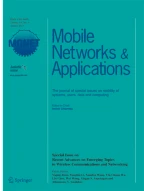Abstract
Wireless networks play a very important role in today’s modern world, convincingly surpassing the wired infrastructure in terms of popularity. Hence, it is important to ensure that services which access wired networks should also be accessible using a wireless network without any performance degradation. One of the most common variants in wireless communications is the Wireless Mesh Network (WMNs). WMNs exploit multi-hop wireless communications between wireless access points. Hence, the effective bandwidth decreases as the number of hops increases in a WMN, thus increasing latency and resulting in reduced performance. This may be due to spatial contention, multipath fading, interference or inefficient queuing mechanisms etc. Here we take queuing mechanisms into consideration and study the QMMN algorithm (Queue Management for Multi-hop Networks) which tends to improve throughput, fairness and reduce global synchronization problems. Based on our study, we implement a modified version of the QMMN algorithm, otherwise called the Enhanced QMMN (EQMMN) algorithm. EQMMN can be considered an effective algorithm which solves the problem of fairness between flows (either responsive or unresponsive) and eventually improves TCP throughput at wireless access points. Our experimental results prove that EQMMN algorithms have better performance characteristics such as throughput (TCP) and fairness index compared to QMMN algorithms.
Similar content being viewed by others
References
Nadiraju NS (2007) A cross-layered approach for achieving fairness in multi-hop wireless mesh networks. PhD dissertation, University of Cincinnati, Cincinnati, Ohio, USA. May
Nadiraju NS, Nadiraju DS, Cavalanti D, Agarwal DP (2006) A novel queue management mechanism for IEEE 802.11s based mesh networks. In Performance, Computing and Communications Conference, 2006, IPCCC 2006, 25th IEEE International, pp-168, Apr 2006
Gambiroza V, Sadeghi B, Knightly EW (2004) End to end performance and fairness in multi-hop wireless backhaul networks. In MobiCom ’04: Proceedings of the 10th Annual International Conference on Mobile Computing and Networking, pp 287–301
IEEE Std. 802-.11 (1999) IEEE standard for wireless LAN medium access control (MAC) and physical layer (PHY) specification. ISO/IEC 8802-11:1999 (E), Aug 1999
Jain R, Chiu D, Hawe W (1984) A quantitative measure of fairness and discrimination for resource allocation in shared computer systems. DEC Research Report TR-301, Sep 1984
UCB/LBNL/VINT Network Simulator (NS- v2.33). Available: http://www.isi.edu/nsnam/ns/index.html [Accessed: Mar. 10, 2009]
The Network Simulator ns-2: Documentation. Available: http://www.isi.edu/nsnam/ns/ns-documentation.html [Accessed: Mar. 11, 2009]
Issariyakul T, Hossain E (2009) Introduction to network simulator NS-2. Springer, NY
